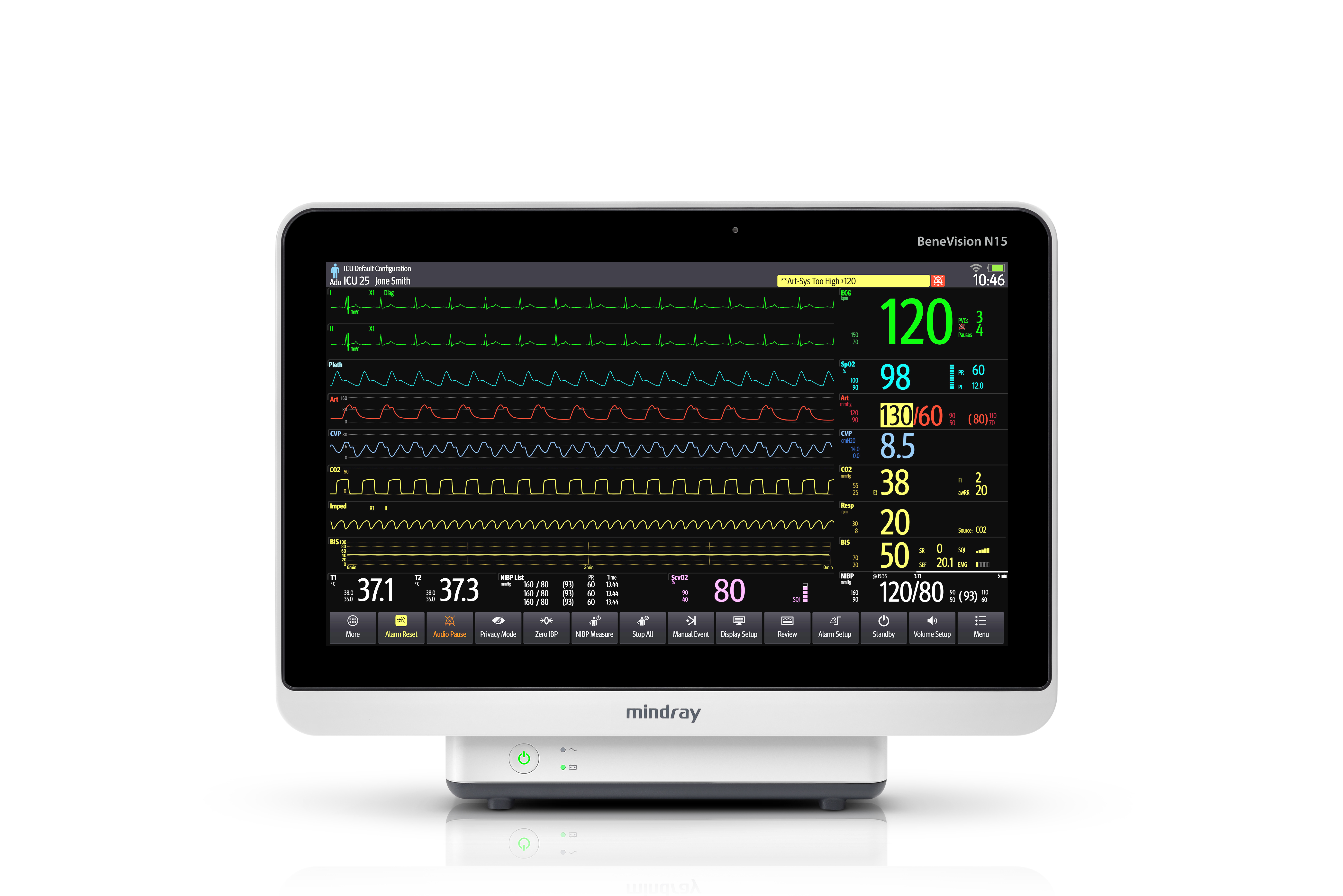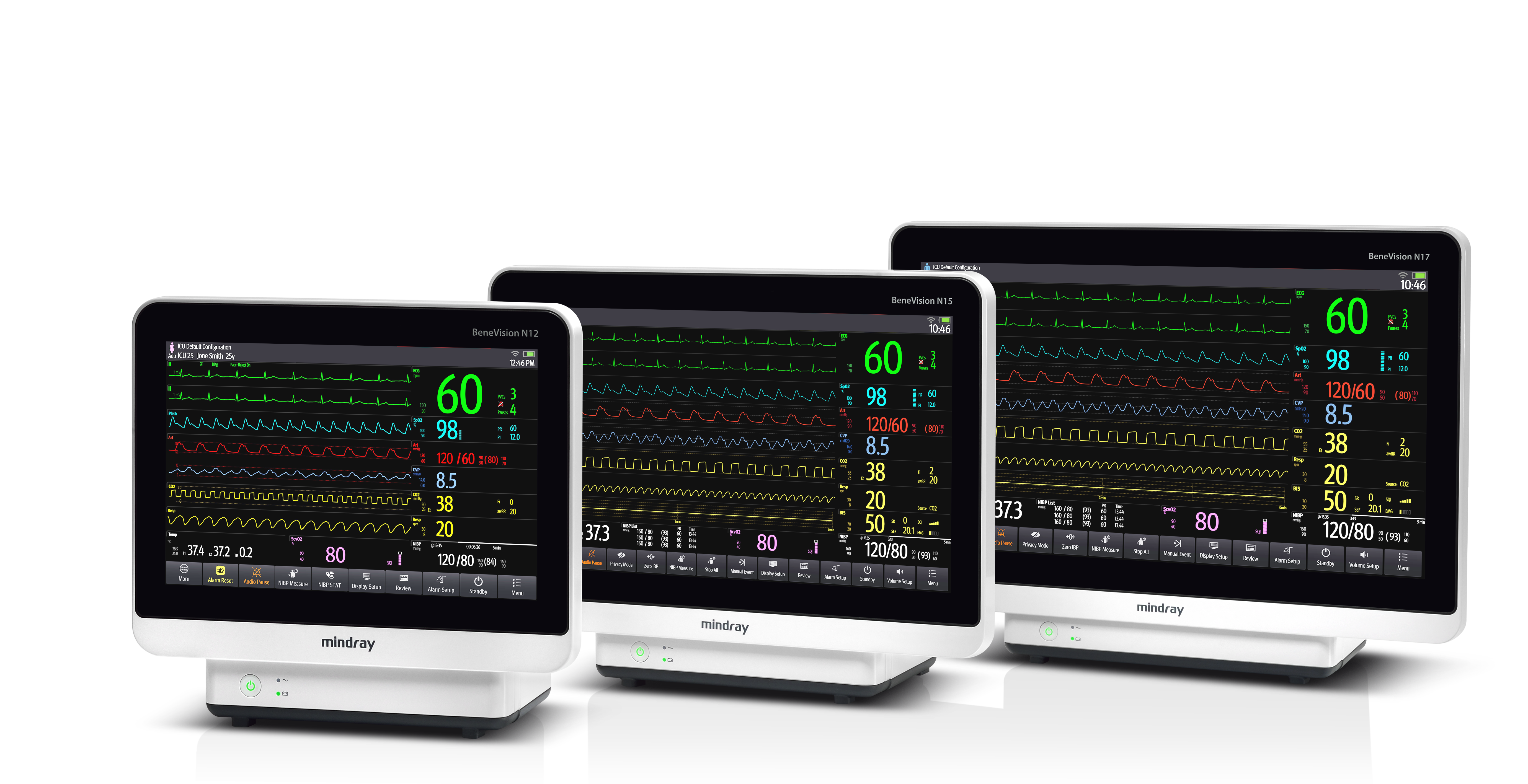Mindray BeneVision N15 patient monitor
The BeneVision N version patient monitors are designed to monitor, display, view, store, alarm and transmit various physiological parameters. This monitor is intended for use in healthcare facilities by or under the direction of healthcare professionals. It is not intended for use in helicopters, ambulances, or at home. Settings may vary depending on the configuration selected.
Free shipping
Guarantee
Features
- All parameters can be monitored for a single adult, child or neonate patient with the exception of the following: BIS, BSV, ScvO2 and NMP (intended for adults and children only), cardiac output (adults only)
- The monitor allows you to enter data using the touch screen, keyboard, mouse, navigation knob, remote control
- You can temporarily disable the touchscreen to avoid false and accidental taps
- The monitor can be configured with either the Glasgow algorithm for 12-lead ECG analysis or the Mindray algorithm for 12-lead ECG analysis
- Everything you need to work with a monitor is on its screen. Almost every screen element is interactive. Screen elements include parameter values, curves, shortcuts, information fields, alarm fields, and menus
- You can enter information using the on-screen keyboard
- You can use the mouse to select screen elements
- The monitor is equipped with shortcut keys for instant access to certain functions
- Operating modes: monitoring mode, confidential mode, night mode, standby mode
- Automatic daylight saving time function
- You can connect an additional display to the monitor
- Edit patient information after registration, in case of incomplete data entry, or if you need to change patient information
- The monitor can be connected to a central monitoring system via a wired or wireless LAN
- Real-time data, curves, and alarms can be sent from the monitor to the healthcare facility's servers using the HL7 protocol
- The monitor supports 2.4G and 5G
- You can pair the TM80 telemetry monitor and BP10 nat module with a monitor for measuring ECG, SpO2 and nat for outpatients (adults and children)
- TM80 can be connected to a monitor via MPAN or Wi-Fi
- The monitor can be connected to external devices, such as ventilators and anaesthetics, to another monitor
- The monitor is equipped with an automatic alarm limits function to automatically adjust the alarm limits according to the patient's vital signs in use
- Electrocardiography (ECG) measures the electrical activity of the heart, which is displayed on the monitor in the form of curves and numbers. ECG monitoring provides ECG monitoring in 3, 5, 6 and 12 leads, ST segment analysis, arrhythmia analysis and QT/QTc measurement
- Clinical applications can improve the efficiency of a doctor's work. However, they are not intended for direct diagnosis and cannot replace a doctor's assessment
- The monitor performs the following functions: calculation of medicines, haemodynamics, oxygenation, ventilation, kidney function
- Wi-Fi module
- The printer can be connected to the monitor via the network to output patient reports
Characteristics
- Display.: 15.6 inches, touchscreen
- Dyslexia resolution: 1920 x 1080 pixels
- ECG monitoring: 3, 5, 6, 12 leads
- Operating time on a single battery: 2 hours
- Mode of operation: continuous
- Weight: 5.4 kg
- USB port: 4
- RJ45 port: 1
- Temperature monitoring: Yes
- SpO2 monitoring: Yes
- CO2 monitoring: Optional
- NIAT monitoring: Yes
- IAT monitoring: Optional
- AG monitoring: Optional
- Monitoring of cardiac output: Optional
- Monitoring of the ECG: Optional
- BIS monitoring: Optional
- Monitoring of mechanical respiratory parameters: Optional
- Monitoring of continuous cardiac output: Optional
- Monitoring of central venous blood oxygen saturation (ScvO2): Optional
- Electroencephalogram (EEG): Optional
- Monitoring of neuromuscular transmission (NMT): Optional
- Monitoring of regional oxygen saturation (rSO2): Optional
- Features
- Characteristics
- All parameters can be monitored for a single adult, child or neonate patient with the exception of the following: BIS, BSV, ScvO2 and NMP (intended for adults and children only), cardiac output (adults only)
- The monitor allows you to enter data using the touch screen, keyboard, mouse, navigation knob, remote control
- You can temporarily disable the touchscreen to avoid false and accidental taps
- The monitor can be configured with either the Glasgow algorithm for 12-lead ECG analysis or the Mindray algorithm for 12-lead ECG analysis
- Everything you need to work with a monitor is on its screen. Almost every screen element is interactive. Screen elements include parameter values, curves, shortcuts, information fields, alarm fields, and menus
- You can enter information using the on-screen keyboard
- You can use the mouse to select screen elements
- The monitor is equipped with shortcut keys for instant access to certain functions
- Operating modes: monitoring mode, confidential mode, night mode, standby mode
- Automatic daylight saving time function
- You can connect an additional display to the monitor
- Edit patient information after registration, in case of incomplete data entry, or if you need to change patient information
- The monitor can be connected to a central monitoring system via a wired or wireless LAN
- Real-time data, curves, and alarms can be sent from the monitor to the healthcare facility's servers using the HL7 protocol
- The monitor supports 2.4G and 5G
- You can pair the TM80 telemetry monitor and BP10 nat module with a monitor for measuring ECG, SpO2 and nat for outpatients (adults and children)
- TM80 can be connected to a monitor via MPAN or Wi-Fi
- The monitor can be connected to external devices, such as ventilators and anaesthetics, to another monitor
- The monitor is equipped with an automatic alarm limits function to automatically adjust the alarm limits according to the patient's vital signs in use
- Electrocardiography (ECG) measures the electrical activity of the heart, which is displayed on the monitor in the form of curves and numbers. ECG monitoring provides ECG monitoring in 3, 5, 6 and 12 leads, ST segment analysis, arrhythmia analysis and QT/QTc measurement
- Clinical applications can improve the efficiency of a doctor's work. However, they are not intended for direct diagnosis and cannot replace a doctor's assessment
- The monitor performs the following functions: calculation of medicines, haemodynamics, oxygenation, ventilation, kidney function
- Wi-Fi module
- The printer can be connected to the monitor via the network to output patient reports
- Display.: 15.6 inches, touchscreen
- Dyslexia resolution: 1920 x 1080 pixels
- ECG monitoring: 3, 5, 6, 12 leads
- Operating time on a single battery: 2 hours
- Mode of operation: continuous
- Weight: 5.4 kg
- USB port: 4
- RJ45 port: 1
- Temperature monitoring: Yes
- SpO2 monitoring: Yes
- CO2 monitoring: Optional
- NIAT monitoring: Yes
- IAT monitoring: Optional
- AG monitoring: Optional
- Monitoring of cardiac output: Optional
- Monitoring of the ECG: Optional
- BIS monitoring: Optional
- Monitoring of mechanical respiratory parameters: Optional
- Monitoring of continuous cardiac output: Optional
- Monitoring of central venous blood oxygen saturation (ScvO2): Optional
- Electroencephalogram (EEG): Optional
- Monitoring of neuromuscular transmission (NMT): Optional
- Monitoring of regional oxygen saturation (rSO2): Optional



